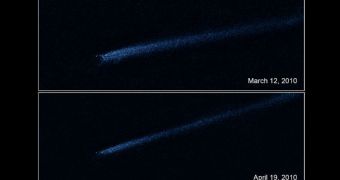NASA experts believe they may have observed the first known signs of an asteroid collision taking place in space. The possible event was recorded using the Hubble Space Telescope.
The observatory was used to snap a series of shots of a peculiar structure that had an X-shaped object flying at the forefront of a debris field similar to the one left behind by comets as they near the Sun.
Astronomers tracked the phenomenon as it unfolded over a period of five months. The observations began in January, and Hubble was used because of its large observational power.
After some month of studies, the team started getting excited that it had just observed the first-ever asteroid collision known to man, when experts determined that the actual impact took place sometime in early 2009.
“We expected the debris field to expand dramatically, like shrapnel flying from a hand grenade,” explains expert David Jewitt.
“But what happened was quite the opposite. We found that the object is expanding very, very slowly,” adds the scientists, who holds an appointment as an astronomer at the University of California in Los Angeles (UCLA).
He is also the leader of the research team that carried out the Hubble observations. His group dubbed the weird object P/2010 A2.
The scientists say that it was discovered orbiting the Sun in the inner asteroid belt, which is a large area filled with rocky debris, asteroids and meteorites that expands beyond the orbit of Mars.
According to estimates, asteroid collisions are not rare events, with one believed to take place every year. However, most of these events take place between small space rocks.
This renders them invisible to even the most advanced telescopes, due to the small amount of light the objects reflect back. Catching the modest-sized P/2010 A2 was very lucky, the team says.
“These observations are important because we need to know where the dust in the solar system comes from, and how much of it comes from colliding asteroids as opposed to 'outgassing' comets,” Jewitt says.
“We also can apply this knowledge to the dusty debris disks around other stars, because these are thought to be produced by collisions between unseen bodies in the disks,” he goes on to say.
“Knowing how the dust was produced will yield clues about those invisible bodies,” Jewitt adds.
“Once again, Hubble has revealed unexpected phenomena occurring in our celestial 'back yard,” says NASA Hubble scientist Eric Smith, from the agency's Headquarters, in Washington DC.
“Though it's often Hubble's deep observations of the universe or beautiful images of glowing nebulae in our galaxy that make headlines, observations like this of objects in our own solar system remind us how much exploration we still have to do locally,” he concludes.

 14 DAY TRIAL //
14 DAY TRIAL //